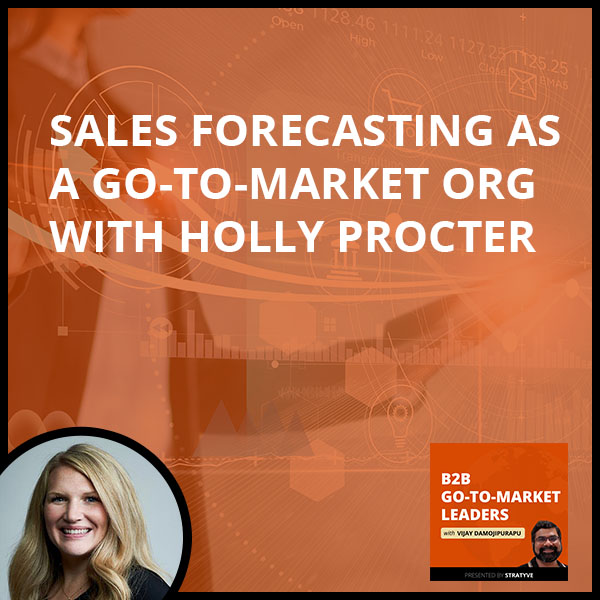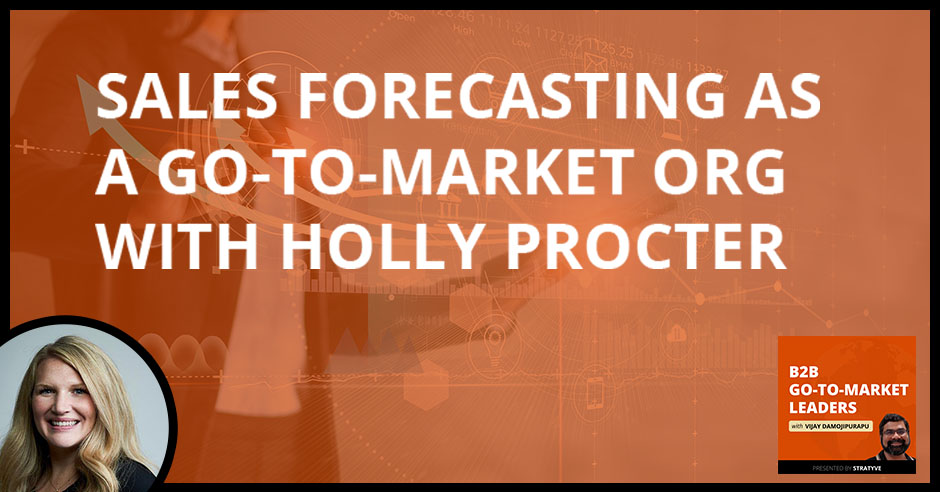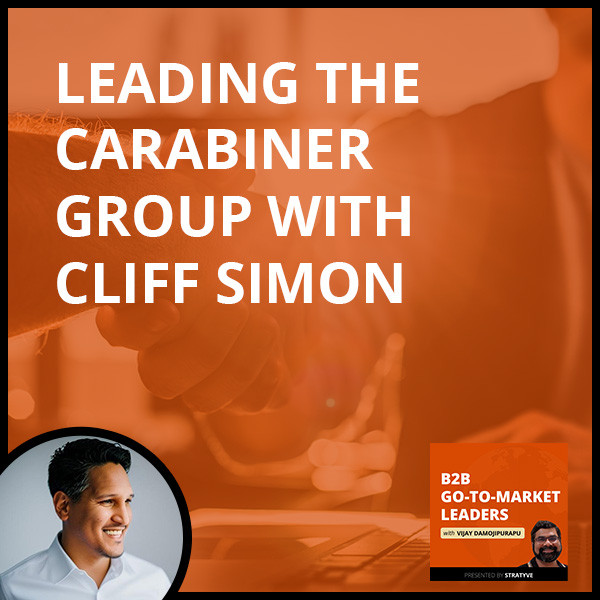
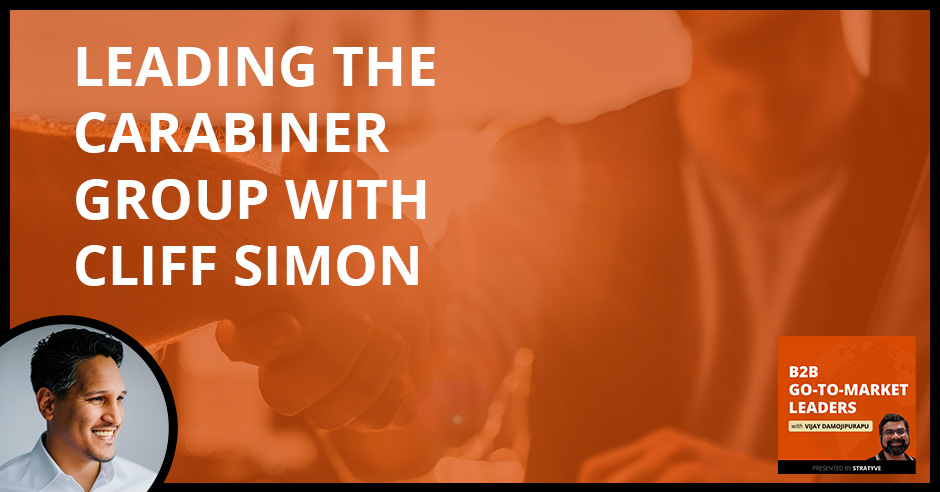
Your RevOps solution is here! It lies in the hands of the Carabiner Group. Today, Cliff Simons, the CRO of Carabiner Group, shares the tactics and the actions taken to lead the organization to success. Their agility and nimbleness to turn away problems once they see them coming helped their business deal with the challenging tides. Cliff also shares his GTM success and failure story. Let’s get into this episode with Cliff today.
—
Listen to the podcast here
Leading The Carabiner Group With Cliff Simon
In this episode, I have another great guest lined up. His name is Cliff Simon. He’s the CRO of Carabiner Group. He has a very impressive track record when it comes to go-to-market, building revenue, revenue teams, and so on. Without further ado, let’s welcome Cliff. I’m excited to have you on the show.
Thank you for having me. I appreciate it.
Let’s dive right in. How do you view and define go-to-market?
I have a different take on go-to-market and a lot of folks in B2B do in the sense that a lot of what we do in the B2B space, we’ve tried to make it fit a certain mold or what we think the traditional patterns should be. A lot of what we’ve done from a Carabiner perspective is, “How do you enable your buyers to have a B2B experience that looks and feels as much like a B2C experience as possible? What does it feel like to go through that B2C motion? How do you take away the friction very much like Amazon has done? How do you pull all that friction out of the buying process to make it easy for people to purchase?” I think HubSpot has done a fantastic job of this.
You don’t typically read through all the legal leads of a HubSpot contract because it looks like a checkout screen. If you want to read the legal leads, you have to click on the Ts and Cs. Who’s going to go and fight on the things within a Ts and Cs? You’re naturally conditioned through Apple and everything else to accept the Ts and Cs, scroll through, get to the bottom, and just move on with your life instead of doing the due diligence that most of us would do on any contract that came across our desk. It’s a little bit different from how we would think about go-to-market.
I like the aspect where you are focusing on the buying experience. I’m fully on board with you that B2B should transform itself into creating a buying experience that’s very similar to the B2C world, like the Amazons and Apples of the world. They have revolutionized, for sure. You mentioned over there the click-through and getting started on using a service or a product. There are a whole lot of activities and tons of things that happen for a buyer to come to that point.
There’s so much that has to happen there. That’s why we’re seeing such a big surge in PLG. We’re enabling them to tell us what behavior they want to walk through. They’re enabling us to understand the pieces of technology they want, how they want to deal with it, and what that experience looks like. We’ve been informed because we already know from the Amazons of the world what that experience should look like. We now have to sit back and think, “How do we take that process and engineer it for our specific use case?”
I’m sure we’ll dive deep into several of those topics in our conversation. Shifting gears and going big picture, why don’t you walk us through your career journey, what you’ve been doing, what led you to what you’re doing, and who you serve at Carabiner?
My background is about two decades of go-to-market experience selling in the mid-market enterprise. I started my career off at a Fortune 20 company, highly ranked rep there, did well, and then they took what was making me six figures a year and turned it into a $5,000 quarterly bonus. We all saw the writing on the wall and it was a pretty big exodus at that time. I have spent many years in SaaS. This is my third time doing a 0 to 10, but 0 to 15 before. That’s my first time doing it from the C-Suite.
As far as what we do at Carabiner and how I got here, most people don’t anticipate going into Revenue Operations or RevOps as a career choice. I was that sales leader who enjoyed getting into the data, understanding the why and how, and giving good data feedback to my team. Even for bringing that up to the board and the executive leadership team, this is why things are happening. I had a deep passion for it. Falling into the lucky circumstance of running as a twenty-year-old who is starting a company and getting a chance to help build something from the ground up is intriguing to me.
I got to join Carabiner in its early days when we were just a salesforce consultancy. We made the shift to RevOps as a service in early 2021. I took that very first Revenue Architecture Course that Winning By Design had put on. Jocko was leading it. It was right after the first day of class that we changed all of our positioning and messaging. We went out and picked up a couple of trademarks around RevOps as a service. This is the future. That’s what enabled us to get a decent position from a marketing rather position in the market because it is so much earlier than everybody else did and being holistic about the customer buying journey. Trying to focus on that journey and that experience has helped us stay apart from a lot of the other folks that are coming to the fore.
You started off your journey in sales at telecom companies you are at Nu-Wave Wireless and Verizon, and then you shifted into SaaS. It’s a smart move there. That’s where all the big money is. After that, you joined Carabiner, which provides RevOps as a service to SaaS and technology companies.
A lot of our clients are SaaS. We serve anywhere from series A to D on average. We’ve got folks on the outlying pieces there, some C companies, some series E, and publicly traded, but by and large, a lot of our customers are SaaS. We also work in a regulated industry and a lot of financial services as clients. We also play nicely in the higher education nonprofit space. We’ve seen a lot of folks from manufacturing start coming out and needing services.
That’s been a nice twist from our traditional ICP. When you’re doing the same things over and over again, 80% of it is the same digital transformation, whether you want to call it RevOps or something else. It is a process. How do you look at a customer’s buying journey here, a go-to-market process to it, and only then, how do you build up the technology to meet that process instead of going out and buying all these point solutions like folks have for the last many years?
When you're doing the same things over again, 80% of it's just the same digital transformation, whether you want to call it RevOps or something else. Share on XA funny incident or coincidence was that I had a guest who made a very similar move from the other side. He started off in the services side of the house and then moved into SaaS. You did SaaS and then moved into the services side. He and I were discussing selling services versus selling SaaS are different. At least, SaaS buyers get to see “touch and feel” something versus services only after you build that trust. They speak to current customers, and that’s when they get the confidence. Otherwise, “I’m not 100% buying into what you can deliver for me.” How are you handling that challenge at Carabiner?
For us, it was building trust by building thought leadership. That was accomplished by having a lot of face-to-face interaction, whether in person or on one-on-one Zoom calls with other go-to-market leaders, finding out the pains that they were dealing with, and making sure that we were building a team that could meet that collective need. We’ve got a lot of recognition through our relationships with communities like Pavilion, RevOps Co-op, or the exclusive RevOps partners in both of those scenarios and then working well across the ecosystem.
Once you’ve proven yourself, you start building out some case studies. We were fortunate to get some larger clients very early on when we were doing some massive digital transformation projects that led to the credibility of the work that we could do. Like any small company, you leverage those and keep building. Once you’ve built up a significant body of work, it becomes a lot easier. At this point, we’re seeing 100 reviews between AppExchange, G2, and almost every single one of those. Ninety-five percent of those are five-star reviews. That’s fantastic. We want to keep that up and make sure that we’re giving that level of service to our clients.
What was the revenue ad when you joined Carabiner? That was a few years ago.
I joined in December 2020. The company was 3.5 or 4 months old at that point. We weren’t on an ARR model. It wasn’t recurring revenue. It was nascent. I wouldn’t even register as anything.
In terms of revenue, you are 5, 6, or 7 figures?
We did seven figures in ARR in our first year and then followed that up in 2022 with 4.5X growth, which was incredible. In 2023, somewhere between 10% and 30%, which is not terrible considering the market and the way it is to be able to say that we are going to grow in 2023. I’m impressed that we’re going to hit that number.
For the benefit of the readers, it’s all about the tactics and the actions that led you to this point. Three things stood out for me from what you mentioned. One is being part of communities like Pavilion, which builds credibility. Something else you also mentioned is changing the positioning and improving the buyer experience. The third you mentioned is getting the big brands, the Lighthouse clients. From sequencing, let’s dive into each of those three.
At the core, the reason we’ve done well is what we call agility nimbleness. We have always prided ourselves on being able to say, “If we see a problem coming, we’re going to shift away from it quickly out, bootstrapped, or revenue back,” whatever you want to call it. We don’t have investors that we’re beholden to, which allows us that flexibility.
I don’t have to wait until I go to a board meeting and get them to approve something, which is nice. What that’s allowed us to do around that Amazon desk deal is to take a look at our customers’ journey and say, “What are the things that most people don’t like from consultants? What things do they hate about pro services? How do we take that out of the process?” For us, that means there is no SOW.
Most companies our size and with the capabilities that we’re offering have a very strict scope of work. Meaning that if we go outside of that scope of work, there’s going to be a change order, which means you’re going to have to take 1, 2, 3 weeks for that paperwork to get approved and then paid for, etc. We don’t do that. We want to be able to be very nimble. If our clients have a request, we want to be able to acquiesce to that request so long as they understand what that may do to the rest of the project from a timeline perspective and be able to adjust to that within a matter of days. That’s one thing that we wanted to do.
The other thing that we do is we annual contracts by and large. It’s very different from most of our competitors who are out there where they’re going out to the market and saying, “You’re going to pay us for this particular scope of work. It may take 3 or 6 months.” All we’re going to do is to the letter that’s scope. Because there’s no SOW and we’re coming for the long term, we’re incentivized to build systems that we’re managing that are going to work. Because of that, our Compound methodology, instead of an Agile methodology, our clients see that work gets delivered on a weekly basis and they can understand the value that’s being presented to their organization and the impact that it’s having on a regular basis instead of us going off and building in the dark.
Part of it is how we’re go-to-market and how we’re delivering the services that we’re promising. Those two things coming together create a very different buying experience. What that meant for us as a company is in that first year, we were doing a 6-figure sale on average in 28 days. In 2022, we were doing a 6-figure sale on average in 34 or 35 days. Our ACV increased to damn near $250,000. It was a very significant dollar amount that was moving very quickly.

Six-figure closing under a month is unheard of. Typically, it’s 3 to 6 months. That’s the standard benchmark, but clearly, you got something going. When you described what you guys did from a services point of view, the term that came to my mind was productized services.
That’s very much what we’re trying to do. We have four service offerings, essentially. We have RevOps as a service, which is our flagship service. It’s Salesforce and HubSpot expertise and 150 other pieces of technology that connect in those ecosystems. We have a lower-cost admin service for folks who need a little bit of help. We do an advisory service for people who are trying to understand how to think about that go-to-market, “How do I go about putting these processes in place?” We also do an audit product, which is probably our most popular product.
We do a full scope on people processes, technology, and then insights and analytics, like that data piece. It takes 4 to 8 weeks, depending on the size of the organization, but it’s a pretty comprehensive readout. On the back end of it, you’re getting a very detailed Kanban backlog of, “This is how we recommend going through and fixing your organization and the progression that we believe it should take.” It’s usually done in 0 to 3 to 9 and 18-month increments. You’re getting a year and a half worth of change laid out for you, which a lot of companies find very helpful.
We do an audit product. We do a full scope on people, processes, technology, insights, and analytics like that data piece. Share on XI would assume that most of your clients, if they’re getting to know you and want to engage you on the first service, would start with the audit.
It’s a nice way to say, “Let’s feel each other out. Does everyone like to work? What’s a good communication style?” You start building that connective tissue just like you would when you’re bringing in a regular in-house person.
All of these that you mentioned clearly improve the buying experience, which is 1 leg of the 3-legged stool that we talked about. The second leg was around being part of communities that built your credibility. That’s Pavilion.
When it comes to the community space, it’s how you go about thought leadership and how you add value without always trying to take it. For us, it’s been very much showing up consistently and helping people who have problems. If it comes back to us as revenue or business, great. If it doesn’t, we’ve helped somebody because there are just not enough people doing RevOps.
It’s the number one job on LinkedIn. 8 of the top 25 roles on LinkedIn are RevOps functions. Everyone’s trying to figure this out. We can help point you in the right direction and you don’t have to pay for it. Go and do. If you need more than that, let’s have a different conversation. That’s been us doing webinars, writing white papers, and lots of one-on-one talks like this where if someone’s got a question, we’ll just hop on and have a conversation.
It's great if we can help point you in the right direction and you know how to pay for it, but if you need more than that, let's have a different conversation. Share on XI’ve spent almost two decades in go-to-market across a whole host of industries with a whole host of go-to-market motions. Maybe something I know or a member of our team knows that can help you, let them help you and take that knowledge and go run with it. If that works, please let us know after the fact so that we can celebrate with you and say that it’s been well done. We did the same thing with our customers. When things are going well, tell us. We want to be able to celebrate with you because we want to earn the right to celebrate those milestones together.
The third piece was around getting the big Lighthouse clients and the brands.
That happened a little bit more accidentally, but maybe not quite as accidentally. We ended up working with the largest FP&A runner in the country through cold LinkedIn outreach. We work with 2 of the 3 largest collegiate athletic associations in the country. That was brought to us by one of our IFP partners because they needed somebody with the expertise to build up the systems.
Those systems are used by something in the neighborhood of 1,100 colleges and universities and represent the contracts between those colleges and universities and something in the neighborhood of 150,000 to 160,000 collegiate athletes every year. There is pretty cool stuff to get to do, and I had a lot of exposure because of it. Going after that has been cool, then being able to consistently work for good clients, knowing that a mature executive leadership or going after a very specific private equity or VC firm so we can work together has been good for us as well.
On a lighter note, you started your career as a salesperson, then you grew up the ranks and now you are a sales leader or a CRO. What does your family think or what do they think that you do for work? How would they describe you to others?
My wife comes from a medical background, as most salespeople, especially in the IC role or in mid-leadership. You tend to balance around a decent bit. That was a little hard for her to understand in the beginning. Now, she knows that I do something with software and I get paid to talk to people. It’s outside of her wheelhouse, but she gets most of it and respects it, which is good.
She knows it involves Salesforce and HubSpot. That’s as far as it goes. As far as my family, I’d say probably something similar, my friends all get it because they’re all in tech. Whether I’ve got guys in my hockey team who are Salesforce admins or SAP admins, they all get it. They’re developers. It’s not as far a stretch for most of them. On the family side, it’s different, especially since a lot of my family comes from blue-collar, “You help people and they pay you to do what?”
“All you do is just talk.”
“You talk and you help them think through things? You’re not building something with materials? There’s no actual material cost.” That’s a fun conversation.
A funny story that you shared over there was your family members, specifically your wife and other family members who come from a non-tech background, you versus your other colleagues and friends who come from a tech background. That’s a common theme that I’ve seen. When I ask this question to my guests, it always brings us a good laugh. Thank you for that. Shifting gears here, we all know that go-to-market is not just success and up and to the right always. There will always be failures as well. It would be great if we could share with our listeners both GTM success and failure stories. Pick yours, which one you want to start with.
The success story is pretty easy, considering the amount of growth that we’ve had in the last few years. It’s been crazy. Going back to that whole, people in B2B want to buy B2C and community-led growth. A lot of what we do is community-led. In 2022, 91.5% of all of our inbound and new clients came from community-led word-of-mouth or referrals. Activating and operationalizing that program has been very successful for us. In 2023, we’re trending somewhere between 85% and 90% again. It helps drive customer acquisition costs lower and it makes for a quicker sales cycle because that trust we talked about before is already inherent in the process.
Before we go to the failure story, I want to double-click on the success story. Can you share how big your go-to-market team that includes sales and even on the marketing side and how you break the responsibilities?
We have one AE who works under me. We had gotten up to 4 or 5 at one point. On the marketing side, we had one. We’re about to hire a new marketing associate. On the CS side, we do that by committee because, unlike the SaaS company, we’re talking to our customers every day because we are on the product. It’s a bit different as far as how that gets managed. It’s funny because that bleeds into what I think is the go-to-market failure, which is an inability to see what was coming down the road. This caught everyone by surprise, but how bad it got at the beginning of the year for us being over-indexed on SaaS as a client base, which caused churn.
A lot of companies went under. A lot of people got funding cut out from underneath them and things were seen as a luxury that was previously seen as a necessity just because they had their entire budget wiped out. We ended up losing a couple of clients that way. Because of that, we had to make some head counts being a bootstrap business. For us, that would be a failure having to go through that motion. Now that we’re building back up from it, we’ve learned a lot of good lessons.
From any of your client side, you don’t need to share any confidential private information, but it will be good to share a success story. What was the institution prior to when you guys came on board, how did things change, and how did it improve their go-to-market success?
The coolest ones are probably the NJCAA, which is one of those collegiate athletic associations. They purchased another consulting firm, a product that they thought was going to help handle the entire registration process of all those pieces of tech. They implemented it. Within 30 days of the implementation, they scrapped the entire thing because it wasn’t working. It’s a huge opportunity cost and the actual dollar lost.
They were working with another consultancy to look at how to fix this in Salesforce. It wasn’t moving quickly. They brought us in within two weeks, we had shown them how we would build it, started putting together the prototypes, and they signed a very long-term contract with us in which we got to build all that out, which was cool. The success story for them is that they had never been able to uncover all of the metadata that was wide within that student body.
What they were able to do is take that metadata and bring it back to the Department of Education and get a ton of grant funding because of the way that their student body is made up. Folks, on average, are on the lower side of the economic ladder. Because of that, they ended up pulling in several million dollars in federal funding. It was a cool side piece to trying to solve the problem. They were able to turn that into an economic gain for them.
That’s a big win. You did mention the breakdown of your team both on the sales and marketing side. It looks like most of your team members are Salesforce or HubSpot implementation experts.
Almost our entire company is comprised of either Salesforce or HubSpot, what we call senior consultants or consultants, and in some cases, architects. Those folks are supported by project managers, engagement managers, scrum, and some Lean Six folks. It is very process-driven.
Another cool part of the story that we should be covering is you did mention the founder of Carabiner. What is that story like? Is it he reached out to you or did you reach out to him? How did it all happen?
He had started the company already. A quick story is he was in high school and ended up doing salesforce consulting when he was in high school for an investment bank out in San Francisco. Through that process, he ended up getting an opportunity to speak at Dreamforce before his eighteenth birthday. He was seventeen years old. He continued doing salesforce consulting through undergrad and was supposed to go work for Deloitte Digital doing salesforce consulting, but got his offer letter paused because of COVID. We ended up starting the company. A couple of months later, he and I met on Slack channel, a RevGenius of all places. We met there randomly.
The first day I signed up for RevGenius was early December 2020. We had a call and very quickly led to a series of calls back and forth. It felt right. My wife’s like, “You should definitely go forward and try this out.” Originally, I came on in a fractional capacity because we do fraction in everything, then after my first full week here, it’s like, “We should make this full-time.” We’ve built a great relationship along the way.
If you had told me a few years ago that I would meet some twenty-year-old kid on a Slack channel, we’d have a company together, and we would be building this crazy thing and what it’s become, I never would’ve believed you. It feels so unbelievable. It’s like something you read in a book or it’s in a movie. It’s serendipitous that you meet somebody on a Slack channel then Slack is the number one way in which you engage with most of our client audience. It is a great tool. I love it.
People get a lot of their networking and job leads through LinkedIn, but I think it’s becoming common, especially for more of the entrepreneurial folks who are active in good communities like RevGenius, Pavilion, and others. You can find opportunities. Did he reach out to you or did you reach out to him?
I posted that I was in between roles at the time and I’ve been interviewing for Head of and VP of Sales roles at Series A companies and some enterprise-level roles as an IC to try it out and see what was going to be a good fit. I posted on RevGenius. He reached out to me that day. We had a meeting that afternoon or maybe the next day. He was originally looking for an IC. I wasn’t interested in that. I wanted to build something, especially coming in earlier.
We were able to transition that pretty quickly because of the nature of the questions I was asking him. I wasn’t asking him about, “How much commission am I going to make? How many vacation days am I going to get?” It was, “Talk to me through all your conversion rates. Talk to me about your FP&A.” The second half of my interview process for Carabiner was building out our FP&A for fiscal year ‘21. At that point, I was excited about it. The fact that I was asking business-level questions and we were trying to get to the bottom of what it would look like to grow something intrigued him.
Something that stands out or I get a sense of is you are good at sales. That’s my sense.
I’m okay at sales. There are a lot of people who are a lot better at sales than I am.
What are 1 or 2 things when it comes to the go-to-market side that people reach out to you for like, “I have this burning question and Cliff is a great guy. I should just chat with.”
Usually, it’s a go-to-market process. They’re trying to figure out how to make one piece work or they’re new in a role and they’re ingesting all this information. They want to know my opinion on it. Maybe it’s seemingly simple as sales stage criteria or, “We haven’t necessarily thought about the fact that our mid-market and enterprise sales motions are completely different. How do we bifurcate that from an actual process perspective, and then how do we cement that process difference in technology?” It ranges a wide gambit.
You are good at sales. It’s not just doing part of sales but also the sales process and thinking as a sales leader. That’s what came across right when you mentioned about you and the founder of Carabiner about the FP&A process, plus people reaching out to you for sales entry and exit stages.
What’s at the heart of that is most salespeople are not trained on how to think from a business perspective. I’m trained to think about a specific problem and how my product addresses your problem. Most salespeople are only looking at that problem in a vacuum. They’re not considering the fact that that problem might not be the biggest problem that someone’s dealing with or trying to solve that problem that might only take up one to 2% of my mind share.

It might be a painful enough problem for me to care about fixing it now. You have to find out what the bigger problem is. What is keeping that person up in that area? What do they think about? What are their goals? How does that affect their career mobility? How does that affect ELT, their board, and their share price? Think about those things and how they affect their customers.
Double-clicking on some typical day in the life of Cliff, maybe it’s a week or a weekend, what does that look like?
Let’s break down a week. It’s probably easier. There’s a handful of internal meetings that I’m constantly being pulled into, whether it’s a client escalation, making sure things are going well, or just like the running of the business walking through recruitment, finances, sales, marketing, or whatever it might be. That’s probably something for 5 to 10 hours. I probably spend another 10 to 15 hours involved in sales motions. I probably spend another board five hours a week networking, talking to folks, catching up with friends, seeing what’s going on, and meeting new VCs and PE firms.
There are probably about two hours a week on professional development and learning something new. I spend anywhere from 5 to 10 hours a week vetting new technology, finding out what’s the newest of the new, what’s working well, or, “I haven’t seen this yet. I haven’t seen this in two years, let me get a refresher,” because I want to know what everyone’s using. I want to understand how well it’s being adopted and how it can potentially fit the needs of my customers.
The last piece all comes back to knowing your target customers and buyers well. We should reemphasize or highlight how important it is for each and everyone, especially you as the reader. If you want to get good at either marketing or sales, it doesn’t matter. For anything customer-facing, you need to carve out, spend time, and understand what your customer is dealing with on a daily basis. In your case, it was the technology.
I spend about the other five hours of the week talking to customers and hearing what’s going on with them. The voice of the customer is extremely important in understanding their business challenges so that we can either help stay in front of that and help lead them in some ways or make sure that we’re thinking about it. One of the things that have made us successful is we’ve got some good folks who work for us and will take the time to learn the ins, outs, and nuances of the industries and the sub-verticals that they’re serving.

Typically, I ask my guests what resources they lean on when it comes to shows, books, or community. The community definitely is top of mind for you. It’s very clear.
I lean on Pavilion. A lot of the people I respect the most in the game now are there. I went through CRO school with Pavilion. I still meet with the same cohort of people that I went through that with a few years ago. We’ve met every two weeks for the last few years. That’s been an invaluable resource. I love winning by design stuff, listening to their videos, and getting a chance to go to any of the courses that they offer. The two books that I would recommend the most for Leaders is Extreme Ownership by Jocko Willink. The other would be Matt Blumberg’s Startup CXO: A Field Guide. I love that. It’s great because you can earmark the heck out of it in terms of the chapter that you need for that moment in time.
As someone who’s helping to run a small business where I have to think from a finance, BizDev, and marketing perspective and take all of that in, and I haven’t necessarily had all of those roles throughout my career, that’s been an invaluable guide to just get into the mindset and think through the problems from the way that would particularly look at it. On the other side of that, from a sales guy’s perspective, it helps me get in the mind that much better of the people and my team’s selling to.
I don’t have those books on my list, so I’m going to add those. The final question for you because I know you have little ones to take care of in the business is if you were to turn back the clock, what advice would you give to your younger self? Day one of your GTM journey.
I would learn to be more process-driven earlier on. Don’t be late. I was bad at that when I was younger. That cost me a lot of credibility with folks in leadership. Be more process driven-early on and you don’t always have to be the one that’s right. Have a little more humility earlier on. That’s something we all tend to learn as we get older, but a 23 or 24-year-old Cliff who had been a little bit more humble would have gone a lot farther.
Be more process-driven earlier on. Don't be late. Share on X
The second one, you have clearly fixed it. You are on time or even before time joining the show, so you are not late for sure.
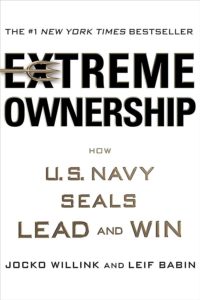
I’ve got one guy on my team who used to work for Jocko, who wrote Extreme Ownership. He was a Navy SEAL for twenty years. I have a daily standup for the team and he is always the first one on the call. Even if I joined five minutes early, he’s the first one on the call. He’s like, “My goal is always to be wherever you are before you get there.” I’m like, “Fair. I can’t argue with you.”
Where can people find and learn more about you Cliff?
If you want to connect with me, find me on LinkedIn. It is pretty easy. I’m Cliff Simon. There is a little cloud in front of my name. That’s the easiest way to get in touch with me. Otherwise, if you’re in any of the communities that I’m in, RevGenius, Pavilion, Wizards Of Ops, or RevOps Co-op, feel free to shoot me a Slack message. I’m happy to have a conversation.
It’s a great conversation. Thank you for sharing a lot of the tactical advice and actionable insights. Good luck to you and the team at Carabiner.
Likewise, thanks for having me on. I appreciate the time.
Important Links
- Carabiner Group
- Extreme Ownership
- Startup CXO: A Field Guide
- Cliff Simon – LinkedIn
- RevGenius
- Pavilion
- Wizards Of Ops
- RevOps Co-op
Love the show? Subscribe, rate, review, and share! http://stratyve.com/

